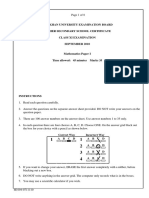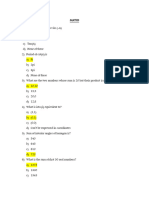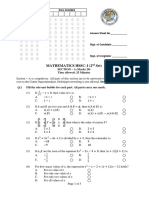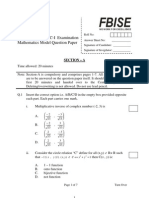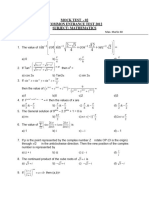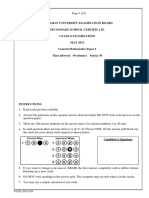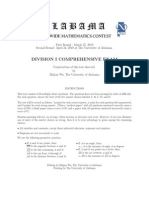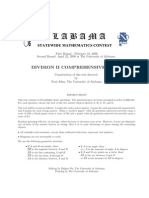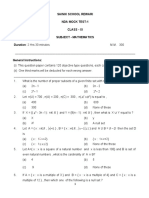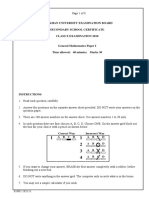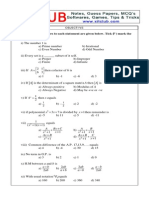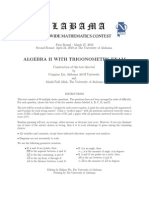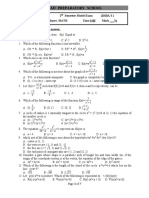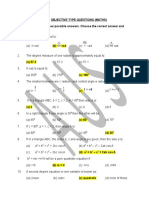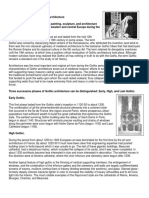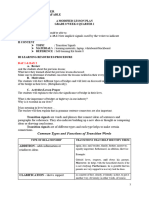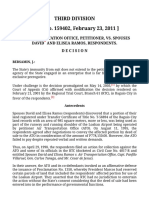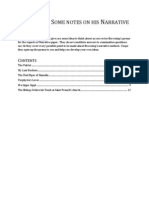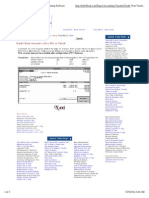Page 1 of 8
AGA KHAN UNIVERSITY EXAMINATION BOARD
HIGHER SECONDARY SCHOOL CERTIFICATE
CLASS XI EXAMINATION 2008
Mathematics Paper I
Time allowed: 45 minutes
Marks 35
INSTRUCTIONS
1. Read each question carefully.
2. Answer the questions on the separate answer sheet provided. Do NOT write your answers on
the question paper.
3. There are 100 answer numbers on the answer sheet. Use answer numbers 1 to 35 only.
4. In each question there are four choices A, B, C, D. Choose ONE. On the answer grid black out
the box for your choice with a pencil as shown below.
Correct Way
Incorrect Way
1 A B C D 1 A B C D
A B C D
A B C D
A B C D
5. If you want to change your answer, ERASE the first answer completely with a rubber, before
blacking out a new box.
6. Do NOT write anything in the answer grid. The computer only records what is in the boxes.
7. You may use a scientific calculator if you wish.
H08A1-071111
�Page 2 of 8
1.
In a conjugate of a complex number
A.
B.
C.
D.
2.
the real part changes its sign.
the imaginary part changes its sign.
the real part and imaginary part both change their signs.
the real and imaginary parts retain their signs.
i17 is equal to
A.
B.
C.
D.
3.
The multiplicative inverse of complex number (0, 1) is
A.
B.
C.
D.
4.
5.
( 1, 0)
(1, 0)
( 0,1)
( 0, 1)
{1, 2} is closed under
I
II
Multiplication.
Addition.
A.
B.
C.
D.
I only
II only
I & II both
neither I nor II
Which of the following is an infinite set? The set of
A.
B.
C.
D.
6.
i
i
1
1
natural numbers between 3 and 10.
real numbers between 3 and 10.
whole numbers between 3 and 10.
integers between 3 and 10.
For a group to be an Abelian group it should possess
A.
B.
C.
D.
associative property.
distributive property.
commutative property.
reflexive property.
H08A1-071111
�Page 3 of 8
7.
8.
9.
If S = {0, 1, 2} is an Abelian group under binary operation as shown in the table. Then the
inverse of 2
0
1
2
0
0
1
2
A.
B.
C.
D.
is 2
is 1
is 0
does not exist
If B is a skewsymmetric matrix then B t is equal to
A.
B.
B
B
C.
( B)t
D.
( B) t
1 0 2
If A = 1 2 3 , then determinant of A would be
1 0 2
A.
B.
C.
D.
10.
5
0
5
4
If determinant of matrix A of order 2 2 is , then determinant of matrix 3A would be
A.
B.
C.
D.
11.
1 2
1 2
2 0
0 1
3
6
9
12
The equation, whose sum of roots and product of roots are
A.
B.
ay 2 2by + 4c = 0 .
y 2 + 2by 4c = 0 .
C.
ay 2 + 2by + 4c = 0 .
D.
y 2 2by + 4c = 0 .
2b
4c
and
respectively, is
a
a
PLEASE TURN OVER THE PAGE
H08A1-071111
�Page 4 of 8
12.
Consider the equation x 2 x + 1 = 0 , then values of x (or roots of the equation) are
A.
B.
C.
D.
13.
The equation 2 2 x 3.2 x + 2 + 32 = 0 is called
A.
B.
C.
D.
14.
is 0
is 1
is 1
does not exist
1, 1, 3
1, 1, 3
1, 1, 3
1, 1, 3
The general term of an arithmetic progression whose first term and common difference are 2
and 3 respectively is
A.
B.
C.
D.
18.
1
1
and
2
2
The first three terms of a sequence whose general term is (1) n (2n 3) are
A.
B.
C.
D.
17.
1
2
1
3
The harmonic mean between
A.
B.
C.
D.
16.
a reciprocal form.
an exponential form.
a linear form.
a cubic form.
If one root of equation x 2 + 2 x 3 = 0 is 3 than the other root would be
A.
B.
C.
D.
15.
real and equal.
real and unequal.
imaginary and equal.
imaginary and unequal.
3n 1.
3n + 1.
5n + 1.
5n 1.
The sum of the infinite geometric progression 1, 2, 4, 8 is
A.
B.
C.
D.
1
0
1
H08A1-071111
�Page 5 of 8
19.
If a dice is rolled and a coin is tossed then the possible number of elements in the sample space is
A.
B.
C.
D.
20.
The number of ways to choose 3 students out of 12 students for a painting competition are
A.
B.
C.
D.
21.
B.
C.
D.
1
4
1
2
3
4
1
3
12!6!
is equal to
8!
A.
B.
C.
D.
23.
1728
1320
220
110
If two coins are tossed together, the probability of getting exactly 1 head is
A.
22.
8
12
36
64
3! 3!
9!
2!
4! 6!
12!
56
The number of terms in the expansion of (a + b) 7 is
A.
B.
C.
D.
6
7
8
9
PLEASE TURN OVER THE PAGE
H08A1-071111
�Page 6 of 8
24.
If we expand 3x 2 + 2 y 2
A.
B.
C.
D.
25.
26.
A.
35x 3
B.
35x 2
C.
35x 2
D.
35x 3
If cos =
5
radians in degrees would be
3
100o
150o
210o
300o
tan ( ) is equal to
A.
B.
C.
D.
29.
1
then terminal ray of may be in the
2
III or IV quadrants.
I or II quadrants.
II or III quadrants.
I or IV quadrants.
The angle
A.
B.
C.
D.
28.
fourth and fifth terms.
fifth and sixth terms.
sixth and seventh terms.
seventh and eighth terms.
The fifth term in the expansion of ( x 1) 7 is
A.
B.
C.
D.
27.
)11 , then the two middle terms will be
tan
tan
sec
sec .
2 cos cos is equal to
A.
B.
C.
D.
sin( + ) sin( ).
sin( + ) + sin( ).
cos( + ) + cos().
cos( + ) cos().
H08A1-071111
�Page 7 of 8
30.
cos2 is equal to
A.
B.
C.
D.
31.
If r1 is equal to the radius of the escribed circle opposite to the vertex A of a triangle ABC and
is the area of the triangle then r1 is equal to
A.
B.
C.
D.
32.
sa
s b
sc
sin( + ) sin( ) is equal to
A.
B.
C.
D.
33.
2 cos2 + 1.
2 sin2 +1.
2 sin2 1.
2 cos2 1.
2 sin sin .
2 cos cos .
2 sin cos .
2 cos sin .
The area of the given triangle ABC is
B
A
6cm
4cm
30
C
A.
B.
6 3cm 2
6 cm 2
C.
D.
4 3cm 2
4 cm 2
PLEASE TURN OVER THE PAGE
H08A1-071111
�Page 8 of 8
34.
When y is a real number, the range of y = cos 5x is given as
A.
B.
C.
D.
35.
1 < y < 1.
1 y 1.
5 < y < 5.
5 y 5.
The period of cos
A.
B.
C.
D.
x
is equal to
5
5
2
5
5
10
END OF PAPER
H08A1-071111
